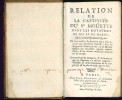MOUËTTE (Germain).
Relation de la captivité du Sr. Moüette dans les royaumes de Fez et du Maroc, où il a demeuré pendant onze ans. Où l'on voit les persécutions qui y sont arrivées aux chrétiens captifs, sous les règnes de Mouley Archy, et de Mouley Seméin son successeur régnant aujourd'huy, et les travaux ordinaires auxquels on les occupe. Avec un traité du commerce, et de la manière que les négociations s'y doivent comporter...
Paris, Jean Cochart, 1683. 1683 1 vol. in-12° de: [6] ff. ; 362 pp. (dont 33 pp. de dictionnaire de langue arabe) ; [5] ff. Ex-libris manuscrit à l'encre brune sur le titre "Quincy St Maurice". (ff. 59 à 62 anciennement maintenu par une épingle, petite trace de mouillure claire à l'angle inférieur des 20 premiers ff., quelques rares taches, sinon frais). Plein veau d'époque, dos à nerfs orné et titré à l'or, roulette dorée sur les coupes, tranches jaspées rouges.
Reference : 4663
Edition originale de cet ouvrage autobiographique dû à Germain Moüette (1651-1691), célèbre pour sa description détaillée de ses onze années de captivité au Maroc consécutives à sa capture par les corsaires de Salé à lâge de 19 ans. Parti pour « les Indes occidentales de l'Amérique » en septembre 1670, Germain Moüette est capturé et vendu comme esclave. Il a ensuite plusieurs maîtres, auprès desquels il exerce divers métiers. Auprès de l'un d'entre eux, le docteur Bougiman, il apprend l'arabe et l'espagnol. Après deux ans passés à Salé, il se retrouve à Fez, où il passe encore deux ou trois ans, puis à Meknès, où il reste six ou sept ans, participant aux vastes chantiers de construction ordonnés par Moulay Ismaïl. Il sera racheté en 1680 avec 45 autres captifs par les religieux de l'ordre de Notre-Dame-de-la-Merci. Il revient alors à Paris en passant par Tétouan, Malaga, Marseille, Toulon et Lyon. Le récit de ses aventures est une source considérable de renseignements de première main pour les historiens sur la vie des esclaves chrétiens capturés par les Barbaresques. C'est aussi un texte très riche sur la vie quotidienne dans le Maroc de l'époque, pour laquelle le docteur Bougiman lui fournit quantité d'informations. Il comporte en outre un vaste glossaire franco-arabe de près de 900 mots et expressions qui occupe les pages 330 à 362 de louvrage, suivi d'une liste des « Noms des Provinces et des Villes appartenantes tant au Roy du Maroc, qu'aux Chrétiens, sur ses côtes ». Provenance : ex-libris manuscrit « Quincy-St Maurice » : Charles Sevin, marquis de Quincy (1660-1728), général d'artillerie français, auteur dune Histoire militaire du règne de Louis le Grand (1726), épousa Geneviève Pecquot de Saint-Maurice. Ils ont eu une fille, Catherine Charlotte Sevin de Quincy (1699-1736). Bel exemplaire. 1 vol. 12mo of: [6] ff. ; 362 pp. (of which 33 pp. of Arabic dictionary), [5] ff. Handwritten bookplate in brown ink on the title "Quincy St Maurice" (ff. 59 to 62 formerly held by a pin, small trace of clear wetness in the lower corner of the first 20 ff., a few rare, if not fresh, spots). Full contemporary calf. First edition of this autobiographical work by Germain Moüette (1651-1691), famous for his detailed description of his eleven years of captivity in Morocco following his capture by the corsairs of Salé at the age of 19. Left for the West Indies of America in September 1670, Germain Moüette was captured and sold as a slave. He then has several masters, with whom he exercises various trades. With one of them, Doctor Bougiman, he learned Arabic and Spanish. After two years spent in Salé, he found himself in Fez, where he spent another two or three years, then he went to Meknes, where he remained six or seven years, participating in the vast construction sites ordered by Moulay Ismaïl. He was redeemed in 1680 with 45 other captives by the religious of the order of Notre-Dame-de-la-Merci. He then returned to Paris via Tetouan, Malaga, Marseille, Toulon and Lyon. The account of his adventures is a considerable source of first-hand information for historians on the lives of Christian slaves captured by the Barbarians. It is also a very rich text on daily life in Morocco at the time, for which Doctor Bougiman provided him with a great deal of information. It also includes a vast Franco-Arabic glossary of nearly 900 words and expressions which occupies pages 330 to 362 of the work, followed by a list of "Names of Provinces and Towns belonging to both the King of Morocco, 'to Christians, on its shores'. Provenance: manuscript ex-libris "Quincy-St Maurice": Charles Sevin, Marquis de Quincy (1660-1728), French artillery general, author of a Military History of the Reign of Louis the Great (1726), married Geneviève Pecquot of Saint-Maurice. They had a daughter, Catherine Charlotte Sevin de Quincy (1699-1736). Beautiful copy.
Bookseller's contact details
J-F Letenneur Livres Rares
M. Jean-François Letenneur
11 bd du tertre Gondan
35800 Saint Briac sur Mer
France
librairie@jfletenneurlivresrares.fr
06 81 35 73 35
 Write to the booksellers
Write to the booksellers

